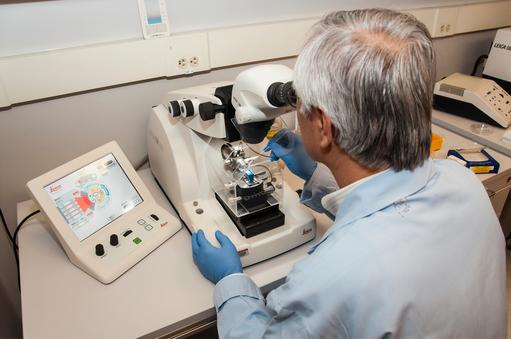- 3m men in the US and 330,000 men in the UK are living with prostate cancer
- The standard test used to diagnose prostate cancer is inaccurate
- This inaccuracy causes anxiety in men and leads to unnecessary treatments
- Standard therapies for prostate cancer can result in incontinence and impotence
- Two new studies describe procedures that promise significant improvements in diagnosis and treatment
New developments in the management of prostate cancer
A vicious circle
There is general agreement on two issues concerning the management of prostate cancer: one, over-diagnosis and overtreatment rates are high; and two, there is a need to refine the standard prostate-specific antigen (PSA) diagnostic test.
The test does not provide information to allow doctors to determine which early-stage prostate tumors pose a risk of being aggressive and need treatment, and which should be left alone. Therefore, efforts to reduce the prevalence of prostate cancer by early detection using the PSA test can lead to over-diagnosis, which in turn can result in overtreatment, which in the case of prostate cancer, can result in incontinence and impotence.
Current official advice to UK GPs says: “The PSA test is available free to any well man aged 50 and over who requests it.” But, “GPs should not proactively raise the issue of PSA testing with asymptomatic men”. And, “GPs should use their clinical judgment to manage symptomatic men and those aged under 50 who are considered to have higher risk for prostate cancer”. In 2014 the National Institute for Health and Care Excellence (NICE) updated its guidelines and suggested that prostate cancer patients should avoid immediate treatment and keep their disease under “surveillance”.
A killer disease on the increase
Prostate cancer is increasing in significance worldwide. In many industrialized countries such as the US and the UK, it is one of the most common cancers and among the leading causes of cancer deaths. In developing countries it may be less common, but its incidence and mortality rates have been on the rise. In the US there are some 3m men living with the disease. It is expected that in 2017, 161,000 new cases of prostate cancer will be diagnosed in the US, and 27,000 men will die from it. In the UK, there are some 330,000 men living with prostate cancer; each year around 47,000 men are diagnosed with the disease, and each year some 11,000 die from it, which equates to one every hour. Worldwide, there are an estimated 1.6m new cases of prostate cancer, and 366,000 prostate cancer deaths annually, making it the most commonly diagnosed cancer in men and the seventh leading cause of male cancer death.
The prostate and prostate cancer
The prostate is a small gland in men, which is located below the bladder and above the rectum. The urethra, which is the tube that carries urine and semen out of the body through the penis, goes through the centre of the prostate. In younger men the prostate is about the size of a walnut, but in older men it can be much larger. Symptoms of prostate cancer include persistent burning, difficult, frequent, uncontrolled or bloody urination in the absence of any infection. The average age of onset is 65 to 69. It is particularly prevalent in African-Caribbean men: affecting I in 4, and killing I in 12, which is double the rate for that of Caucasian men. The main risk factor is age: 80% of all men diagnosed with prostate cancer are over 65. Between 5% and 9% of cases occur in men with a family history of prostate, breast or ovarian cancer. Environmental factors are unclear, but rates of prostate cancer are lower in less urbanised societies, and rates rise when people move to a more westernised diet and lifestyle.
The prostate-specific antigen (PSA) test
In the 1980s a simple and cheap blood test was introduced to detect prostate cancer in its earliest, most curable, stage. In the video below Professor Karol Sikora, a cancer expert, describes the PSA test. Although used to detect prostate cancer, it is not a test for prostate cancer, and as a consequence, it has unresolved challenges. The most significant arises because the test is not accurate enough to either rule out or confirm the presence of cancer. Indeed, it is possible for PSA levels to be elevated when cancer is not present, and not to be elevated when it is present. More than 65% of men with elevated PSA levels do not have cancer. Excessive reliance on the test may lead to unnecessary interventions, while insufficient reliance may cause cancers to be missed.
Biopsies
A biopsy will often be recommended if a PSA test is high. It may also be recommended if a digital rectal examination (DRE) reveals a lump or some other abnormality in the prostate. The most commonly used biopsy for diagnosing prostate cancer is the trans-rectal ultrasound-guided prostate biopsy (TRUS-biopsy). This is a surgical procedure, in which tissue is removed from the prostate for microscopic examination. Each year, over 100,000 prostate biopsies are carried out in the UK and 1m in Europe.
75 to 80% of men who have TRUS-biopsies have no cancerous cells, and therefore did not need the biopsy. 20 to 25% do have cancerous cells, but a large percentage of these do not need any treatment because the cancers are slow growing. A 2014 paper by the Harvard School of Public Health estimates that only 3% of men suspected of prostate cancer have an aggressive tumor requiring immediate intervention.
Further, doctors cannot tell from a biopsy whether cancerous cells are aggressive and need treatment, or whether they are developing slowly and do not require treatment. This creates confusion and anxiety among men, which prompts a percentage to opt for treatment even though the overwhelming majority do not need it. 25% of older men who elect to have treatment will become incontinent or impotent as a result, despite the fact that they did not need the treatment.
Active surveillance
In a significant proportion of men, prostate cancer cells grow slowly and never pose a serious risk to health and longevity. Evidence suggests that early treatment with either surgery or radiation does not reduce mortality rates, but leaves a significant percentage of men with urinary or erectile problems and other adverse effects. As a result, more men are willing to manage their condition by active surveillance, in which doctors monitor low-risk cancers closely and consider treatment only when the condition appears to make threatening moves toward growing and spreading. These men choose to live with prostate cancer until it advances, sometimes avoiding potentially life-altering side effects for several years. Active surveillance is a powerful solution to the problem of over-diagnosis and overtreatment.
New studies promise significantly improved management
Prostate cancer lags behind other cancers in diagnosis, treatment and research funding. But this is beginning to change. Over the past year, findings of two clinical studies promise significant improvements in the management of the condition.
The first, published in 2017 in the Lancet, describes a process, which uses MRI-guided biopsies to improve the accuracy of prostate cancer diagnosis, and spares those who do not have aggressive cancers from undergoing an unnecessary biopsy, so reducing the confusion and anxiety which prostate patients often experience.
The second, published in 2016 in the Lancet Oncology, describes findings of a laser-activated drug derived from bacteria found at the bottom of the sea that attacks and kills prostate cancer cells without either removing or destroying the prostate gland. This is significant because it avoids the potential adverse effects of surgery and radiotherapy, which can render patients incontinent and/or impotent.
The multi-parametric MRI
The 2017 Lancet study used an advanced type of MRI scan, known as a multi-parametric MRI (MP-MRI), which in addition to recording the shape and size of the prostate, also assesses the blood flow through the gland. Led by Dr Hashim Ahmed of University College London, the study was comprised of more than 500 British men with suspected prostate cancer. Results suggest that using the MP-MRI to triage men would safely reduce the number needing a primary biopsy by about 27%, and substantially improve the detection of clinically significant cancers. If subsequent TRUS-biopsies were directed by MP-MRI findings, up to 18% more cases of clinically significant cancers might be detected compared with the standard pathway of TRUS-biopsy for all.
A paradigm shift in prostate cancer treatment
The second study compared the safety and effectiveness of a new therapy called vascular-targeted photodynamic therapy (VTP, also known as TOOKAD), with active surveillance in men with low-risk prostate cancer. It funded by STEBA Biotech, which holds the commercial licence for the therapy. Photodynamic therapy (PDT) is not new, and has been used to treat skin and other cancers where light can easily penetrate. VTP therapy, however, is viewed as a paradigm shift in prostate cancer care. It involves injecting a light-sensitive drug (padeliporfin or WST11) into the bloodstream, and then activating it with a laser to destroy cancerous tissue. The benefit of this approach is damage to healthy prostate tissue is minimised, reducing the risk of side effects.
Findings
The study was comprised of 413 men at low risk of prostate cancer, and carried out across 47 treatment sites in 10 European countries, most of which were performing VTP therapy for the first time. Only men classified with low-risk cancer were included in this study. Participants were randomly assigned either to VTP therapy or active surveillance. At the end of two years, of the 196 men who received the VTP treatment, about half showed no signs of the disease, compared with 13.5% of those given standard care. Only 6% of the VTP group later needed radical treatment, compared with 30% of active surveillance patients. VTP treatment also doubled the average time of cancer progression from 14 to 28 months. Findings suggest that 49% of patients treated with VTP therapy went into complete remission compared with 13.5% in the control group.
A third of the VTP group experienced side effects compared to only 10 of the active surveillance group. Notwithstanding, the study concluded that, “VTP therapy is a safe, effective treatment for low-risk, localised prostate cancer, which might allow more men to consider a tissue-preserving approach and defer or avoid radical therapy”. Patient monitoring will continue in order to ascertain whether the cancer stays away. Further studies should help to understand better which cancers VTP treatment is most appropriate for so that men can make more informed treatment decisions.
Study enhanced by MRI scanning
The study was conducted with people at low risk of prostate cancer. Those at very low risk are better off with no treatment and no adverse-effects. Professor Mark Emberton of University College London, the lead author of the study, believes the therapy will be most useful in patients in the “grey zone”, between low and high risk. “The fact that the treatment was performed so successfully by non-specialist centres in various health systems is really remarkable”, says Emberton because the lack of complication suggests that the treatment protocol is safe, and relatively easy to scale.
At the beginning of the study MRI scans were not universally available, and Emberton believes MRI scanning as suggested by the Ahmed 2017 study will have a significant positive effect on prostate cancer treatment in the future. When carrying out biopsies without guidance from MRI scans researchers had to guess where in the prostate the cancer was; so biopsies were sub-optimal. “If they were to do the study now, with the help of MRI scans, they could hit the cancerous parts of the prostate rather than going in blind and the results would be much better,” says Emberton.
Takeaways
These two recent studies are potential “game changers”. They promise to significantly enhance the management of prostate cancer and substantially reduce the uncertainty and anxiety, as well as the risks of the life altering side effects of treatment, experienced by millions of men living with the disease.
|







